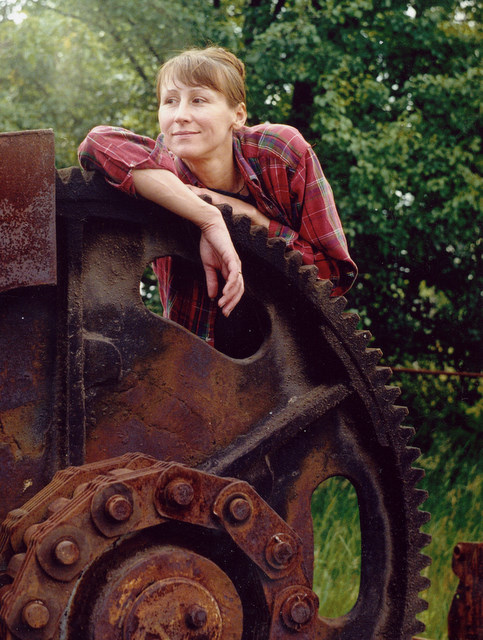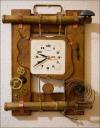 People starve to be different. The least likely of places you’d expect find individualism was Soviet-controlled Ukraine in the 1970s. Let me tell you about finding uniqueness among the seemingly generic, and a person that discovers and displays it.
People starve to be different. The least likely of places you’d expect find individualism was Soviet-controlled Ukraine in the 1970s. Let me tell you about finding uniqueness among the seemingly generic, and a person that discovers and displays it.
It was purely accidental that I learned about Olga Narozhna and her work. She is a one of the kind artist, hard to find if you are not looking in the right places. Olga is an artist consumed with the representation of time. Most of her work incorporates some component from a watch or clock, working or in fragmented form. The imagery of time is beautiful to Olga, “I see clocks as art, and then as the time.”
Artists like Olga don’t exist to be found, so one has to probe. eBay is a waypoint for the interesting, the hard to get, and the value-endowed. Recently, I found an interesting type of watch that I had never seen before. It wasn’t a particular brand, nor was it anything mass produced, but rather a piece of watch art. Labeled under the item tag “Steampunk,” this untitled work from Olga drew on the popularity of the steampunk movement, but was never designed as such. It just happened to be the case that Olga’s natural tendencies were to form steampunk art, not even realizing it. The watch I saw was a beneficent Frankenstein of antiqued relics. A mixture of the mass production and organize form. The base was a working digital watch with a mosaic of gears and leather arranged organically, but with purpose. Olga’s art is watch impressionism, playing with the concept of form and function to suggest a theme of functional imagery.
The steampunk style requires no explanation to some, and for others it might sound like a rebellious adolescent who hangs out at a Chinese laundry. In fact, the idea comes from a design style based on industrialization era futurism and mechanics. Hearkening to a time when steam power ran machines and the future was dictated by Jules Verne, steampunk is retro futuristic when industrial design was a gentleman’s pursuit and nothing such as plastic or semi-conductors were ever heard of. Pure steampunk style is like Renaissance faire clothing for Victorian era purists, but the clockwork fascination has taken everyone from weekend goths, to the leather crowd by storm. Some would say it is a subconscious rebellion to the mass produced culture of disposable goods; to brandish exposed watch and clock gears reminiscent of when craftspeople solely made such items. Others simply attribute the steampunk style as a fanciful expression of modern impressionism. Either way the visual appeal is immediate, and the tangible novelty is lasting.
 Olga grew up in the strangest of worlds. Communism provided life essentials without any frills. Poverty was granted, and luxury was a derogatory term. While one had everything needed, there was little with which to express one’s self. Olga’s family was a bit different. “Even though communism struggled to make everyone grey and homogenized,” Olga had a few shades of color in her family. “My family was very educated and cultured,” having deep Ukrainian tradition Olga’s family has relics of the past. Embroidered furniture, China porcelain, and pictures of proud ancestors, were all things Olga had to remind her who she was, and where she came from. In that grey society she needed memory.
Olga grew up in the strangest of worlds. Communism provided life essentials without any frills. Poverty was granted, and luxury was a derogatory term. While one had everything needed, there was little with which to express one’s self. Olga’s family was a bit different. “Even though communism struggled to make everyone grey and homogenized,” Olga had a few shades of color in her family. “My family was very educated and cultured,” having deep Ukrainian tradition Olga’s family has relics of the past. Embroidered furniture, China porcelain, and pictures of proud ancestors, were all things Olga had to remind her who she was, and where she came from. In that grey society she needed memory.
 Fascinated by artists such as Dali and Escher, Olga has a strong connection to functional abstraction. The idea of a machine that runs and yet does not produce a meaningful end product; the twisted hands of a Dali clock that cannot tell time, or the looped stairways of an Escher building. A lot like the communist regime, twisted in execution. Olga’s art warps the concept of utility into an abstract execution of mechanics.
Fascinated by artists such as Dali and Escher, Olga has a strong connection to functional abstraction. The idea of a machine that runs and yet does not produce a meaningful end product; the twisted hands of a Dali clock that cannot tell time, or the looped stairways of an Escher building. A lot like the communist regime, twisted in execution. Olga’s art warps the concept of utility into an abstract execution of mechanics.
In Kiev, Olga had little recognition for her creations at first. Looking back, Olga was not yet 30 years old when the Soviet Union fell. Caught in the midst of a joyful time, Kiev was reeling from fallout of the iron curtain. A new era of creativity was upon them after the fall, it was something new. During Soviet times creativity was stunted. Instead, invention became art. People needed to be resourceful – reuse parts, fix machines, and rarely buy anything new. It was from this reality that Olga drew much of her influence. Against the backdrop of an aging European city with its classic architecture stood need for invention. The ideal combination of elements that go into the steampunk aesthetic. After the fall of the USSR, things changed and Olga started making her clocks.
“The working class hated artists and creative types.” Olga had to wait until her daughters grew up before she felt safe enough to share her art. Displaying her art in the popular Adreevski district gave her the reassurance to further develop her craft and show the world its artifacts and memories she felt was forgotten. Her art is also about stopping time. Using the past artifacts today, she shows how time is relative and in the same instance it is a constant.
Olga is a craftswoman dedicated to her art. Olga does not make watch or clock movements, and she never will. Watch making as a trade is rare and time consuming. Olga would prefer to work with the old in making the new. Instead of making new clocks and watches, Olga uses her clock art to make a statement about the whole concept of what a clock should be. Growing up, the biggest clock in our lives was probably in our school rooms. Children spend timeless hours trying to make it go faster. And as an adult, we cannot seem to impede the hands from making their course. Olga’s clocks are not about time moving, they are about viewing the clock as an end in itself. This is a theme for Olga as most of her clocks are centered in the integrated frames she typically constructs.
 Olga recently learned about the steampunk style by name. It seemed like a logical extension of her existing work. This unique style seemed to adapt to her. Growing up in Ukraine likely allowed Olga to see many remnants of machines old and new in various states of disrepair. As an arm of the old Soviet Union, Ukraine had its share of communist era relics. Pieces of industrialization. Remnants of the failed good intentions and ill execution of communist socialism. Olga remarks on how she finds much of her inspiration and parts at flea markets, swap meets, and other collections of discarded treasure. By all mechanical standards, nothing Olga works with is modern, and she likes it that way. There is art and beauty in the components of progress. Old pipes, watch gears, pieces of wood, and furniture fittings. Bolts, buttons, screws, and nails. These are the foundational elements that make up the otherwise organic matter civilization has taken for granted the last 100 years or so.
Olga recently learned about the steampunk style by name. It seemed like a logical extension of her existing work. This unique style seemed to adapt to her. Growing up in Ukraine likely allowed Olga to see many remnants of machines old and new in various states of disrepair. As an arm of the old Soviet Union, Ukraine had its share of communist era relics. Pieces of industrialization. Remnants of the failed good intentions and ill execution of communist socialism. Olga remarks on how she finds much of her inspiration and parts at flea markets, swap meets, and other collections of discarded treasure. By all mechanical standards, nothing Olga works with is modern, and she likes it that way. There is art and beauty in the components of progress. Old pipes, watch gears, pieces of wood, and furniture fittings. Bolts, buttons, screws, and nails. These are the foundational elements that make up the otherwise organic matter civilization has taken for granted the last 100 years or so.
Several years ago Olga left Ukraine. Living in the United States resulted in a dramatic shift for Olga’s artistic inspiration. California is cleaner, more generic, and less abundant with street art than many places, in particular Kiev. By no means devoid of culture, California didn’t have the signs of age and invention that Olga had once experienced daily. To reinvigorate the outlet of expression, Olga turned to absorbing popular, as well as underground art. Artists must be aware of that which is being created around them. The Internet provided an excellent venue to learn of, and visualize the works of others. This is where Olga eventually learned that her style was reminiscent of steampunk.
An artist is never alone when surrounded by inspiration. Visiting galleries and observing the works of fellow artists gives Olga a new insight on technique and provides direction. Olga is a tactile person like most artists. Her biggest surges of creative passion flow from encountering new materials. As much an artist as a collector, Olga travels far and wide gathering new materials, parts, and mechanical refuge for eventual incorporation into art. Not the first artist to practice ambitious recycling, but certainly an excellent example.
Today Olga is dedicated to furthering her progress as an inventor and artist. She sees her creations as sculptures, which they undoubtedly are, but few would identify them as such. We tend to think of sculpture as motionless and static. Olga’s clocks are anything but still. Most are perfectly functioning clocks, she does not like the idea of useless clutter. There is utility in her aesthetics.
Merely having dipped her feet in the steampunk style, Olga is planning a serious dive into the genre. Her plans include an expanded series of steampunk clocks, sculptures, watches, jewelry, and of course a gallery-wide exhibition. For those lucky enough to attract her attention, she takes select commissioned projects that interest her. In the meantime, Olga will continue to be herself, and steampunk style will follow.
Visit Olga Narozhna’s eBay store here. A website destination for her is currently under construction.
See Olga’s NEW (Summer 2008) website here at Olga Clock Works.
See more of Olga Narozhna’s work on her MySpace page here.
[phpbay]steampunk watch, num, “”, “”[/phpbay]
